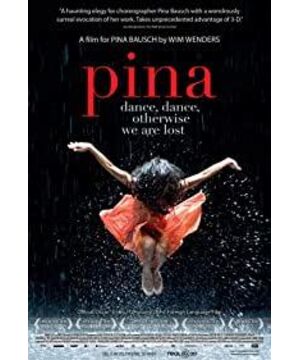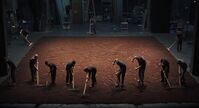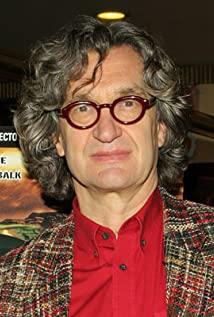There is another piece of information you should know: whichever group you belong to, your view might be turned upside down by Pina Bausch, the center of the film and late German choreographer who has defined the landscapes of modern dance in the past century, along with Merce (Cunningham), Martha (Graham), Alvin (Ailey) and a few others also identified on a first-name basis. It might be cliché to claim her life rather than career as her definitive art, yet the sorrow, loneliness, love and pain in her works exude such intimate beauty that one can hardly imagine anything less than full devotion of a vibrant soul. Therefore, the film's focus on her dancers rather than herself seems particularly extraordinary.Her unfortunately early departure is part of the reason — she died of unspecified cancer five days after diagnosis and merely two days before the shooting of this film. Yet from another perspective, her dancers best embody Pina's essence — through collective performance, personal solos, video footages and interviews (presented with shots of them speechless while their narrations play in the background) — Pina's dancers provide lively testimony of her conviction, spirit and fragility as strength.
What is “PINA,” after all? It is an Academy Award-nominated documentary (lost to “Undefeated” three days ago, a feature that zeroes in on the struggles of a high school football team in Memphis), 3-D theater, fiction, personal account and dance altogether. It is the multiplication of revamping, re-examining, restaging, reconstructing, reviewing, recognizing, reminiscing and pure rejoice. Edgy and radical with every breath of time, it is a celebration of the grace and ugliness of humanities. But Pina was not radical for radical sake. Ceaselessly challenging to physical limits and social norms as her works might have been, her efforts reach beyond forms and semantics to weave a web of emotions and ideas.
As one of the most prominent sociopolitical commentaries in her works, gender dynamics infuse and enervate almost all of Pina's choreography, establishing men and women as (sometimes literally) combating oppositions. With femininity and masculinity in luscious contrast, her women are rarely without vibrant skirts , while her men don suits and workers' uniforms, or bare their chests. Injected into her dancers are doses of sensuality, longing, flaming life and lavishness, exposed through constant struggles. Refer to her signature 1975-remake of “Rite of Spring: ” two groups of men and women devour each other's inhabitance with thrilling intensity in what could be read as passages of sexual dominance and fertility, tanned by rich soil under their feet.
Yet gender is not her only focus. Whether placing a ballet dancer in factory complex or the entire ensemble in Bauhaus auditorium, Pina fascinates us with her contextualized exploration of the relationship between human and industrial machinery. In the forms of concrete jungle, suspension bridge, glasshouse in the forest or desolate land near high-rising chimneys, artificially-constructed spaces serve as stimulating premises for dialogue and imagination. It is impossible to look at her works without the space in which they unfold. In one scene, the iconic suspension railway of Wuppertal, where Pina's company (Tanztheater Wuppertal Pina Bausch) is located, creates a hypermodern, sleek yet cloister-like space for dancers to move within as the cityscapes flew by behind the windowpanes. As a result,the absurdist sounds and movements translate into bizarre stanzas of poetry, annotated by nature and faceless technology.
It would be a grave mistake, however, to view Pina as primarily a critic of contemporary society. In many ways, she is anything but. From elegy to ecstasy, Pina creates a lifetime repertoire by acknowledging and embracing, instead of critiquing. “She is a painter,” a dancer recounts. “PINA” faithfully captures the essence of this statement through exquisite cinematography, accenting her work with sweeping, swirling motions and close-ups, both of which were previously disabled in dance theater performances. We then see them all: the beige nebula of billowing dresses, the pulsing ligament, skin, veins and muscles, the shadows of ocean waves that float on torsos and branches, the earthly colors in claustrophobic halls and image after image of the symbolic and the sublime."PINA" challenges Merce Cunningham's words on dance as giving us "nothing but that single fleeting moment when you feel alive," for it succeeds in capturing on film the vivid beauty that has set decades of imagination on fire.
Would Pina Bausch disagree with Cunningham then? Probably not, for in that statement, he pins down the very core of Pina's dance, even choreography and movement across time and place: the joy of being alive. I would hazard a guess that for those that contribute to the film and most importantly for Pina herself, few things parallel the moment our bodies break the rigid shackles, whether set by spoken or unspoken rules, for freedom and awareness. It is about unbridled passion, pounding presence and burning desire. It is about art; it is about love; it is our compass. Pina is all about that moment; so is “PINA.”
---
The Amherst Student, Issue 141-17
View more about Pina reviews








